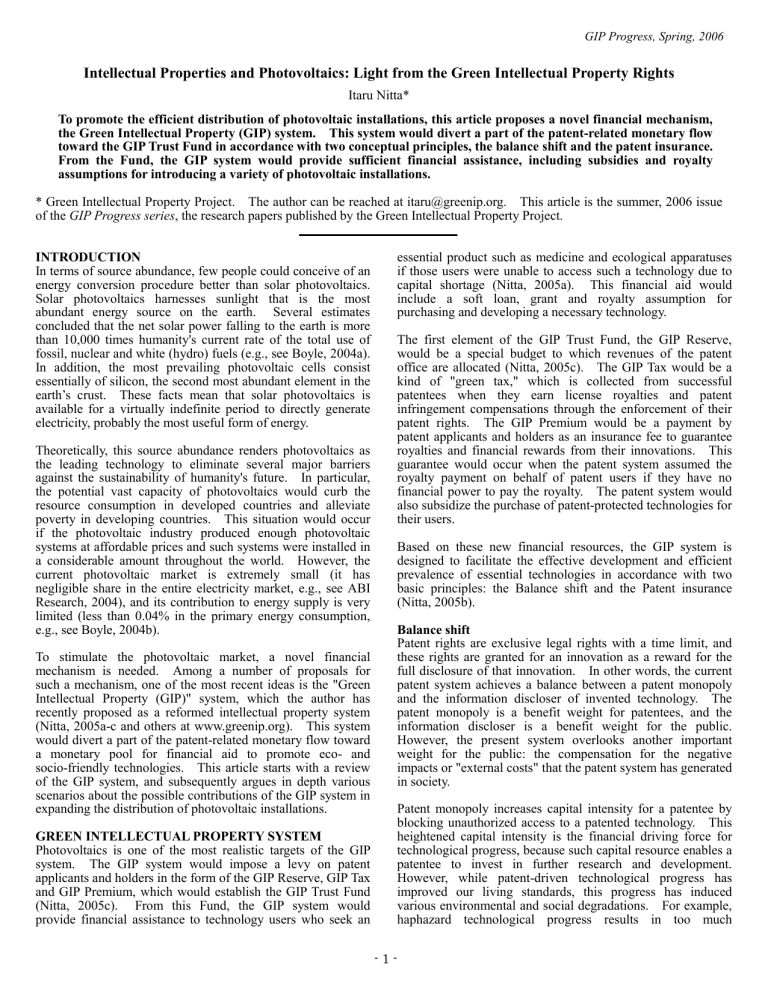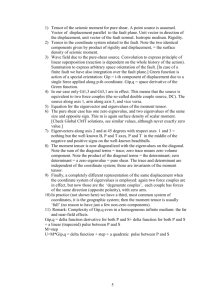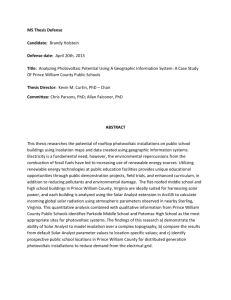Intellectual Properties and Photovoltaics: Light from the

GIP Progress, Spring, 2006
Intellectual Properties and Photovoltaics: Light from the Green Intellectual Property Rights
Itaru Nitta*
To promote the efficient distribution of photovoltaic installations, this article proposes a novel financial mechanism, the Green Intellectual Property (GIP) system. This system would divert a part of the patent-related monetary flow toward the GIP Trust Fund in accordance with two conceptual principles, the balance shift and the patent insurance.
From the Fund, the GIP system would provide sufficient financial assistance, including subsidies and royalty assumptions for introducing a variety of photovoltaic installations.
* Green Intellectual Property Project. The author can be reached at itaru@greenip.org. This article is the summer, 2006 issue of the GIP Progress series , the research papers published by the Green Intellectual Property Project.
INTRODUCTION
In terms of source abundance, few people could conceive of an energy conversion procedure better than solar photovoltaics.
Solar photovoltaics harnesses sunlight that is the most abundant energy source on the earth. Several estimates concluded that the net solar power falling to the earth is more than 10,000 times humanity's current rate of the total use of fossil, nuclear and white (hydro) fuels (e.g., see Boyle, 2004a).
In addition, the most prevailing photovoltaic cells consist essentially of silicon, the second most abundant element in the earth’s crust. These facts mean that solar photovoltaics is available for a virtually indefinite period to directly generate electricity, probably the most useful form of energy.
Theoretically, this source abundance renders photovoltaics as the leading technology to eliminate several major barriers against the sustainability of humanity's future. In particular, the potential vast capacity of photovoltaics would curb the resource consumption in developed countries and alleviate poverty in developing countries. This situation would occur if the photovoltaic industry produced enough photovoltaic systems at affordable prices and such systems were installed in a considerable amount throughout the world. However, the current photovoltaic market is extremely small (it has negligible share in the entire electricity market, e.g., see ABI
Research, 2004), and its contribution to energy supply is very limited (less than 0.04% in the primary energy consumption, e.g., see Boyle, 2004b).
To stimulate the photovoltaic market, a novel financial mechanism is needed. Among a number of proposals for such a mechanism, one of the most recent ideas is the "Green
Intellectual Property (GIP)" system, which the author has recently proposed as a reformed intellectual property system
(Nitta, 2005a-c and others at www.greenip.org). This system would divert a part of the patent-related monetary flow toward a monetary pool for financial aid to promote eco- and socio-friendly technologies. This article starts with a review of the GIP system, and subsequently argues in depth various scenarios about the possible contributions of the GIP system in expanding the distribution of photovoltaic installations.
GREEN INTELLECTUAL PROPERTY SYSTEM
Photovoltaics is one of the most realistic targets of the GIP system. The GIP system would impose a levy on patent applicants and holders in the form of the GIP Reserve, GIP Tax and GIP Premium, which would establish the GIP Trust Fund
(Nitta, 2005c). From this Fund, the GIP system would provide financial assistance to technology users who seek an essential product such as medicine and ecological apparatuses if those users were unable to access such a technology due to capital shortage (Nitta, 2005a). This financial aid would include a soft loan, grant and royalty assumption for purchasing and developing a necessary technology.
The first element of the GIP Trust Fund, the GIP Reserve, would be a special budget to which revenues of the patent office are allocated (Nitta, 2005c). The GIP Tax would be a kind of "green tax," which is collected from successful patentees when they earn license royalties and patent infringement compensations through the enforcement of their patent rights. The GIP Premium would be a payment by patent applicants and holders as an insurance fee to guarantee royalties and financial rewards from their innovations. This guarantee would occur when the patent system assumed the royalty payment on behalf of patent users if they have no financial power to pay the royalty. The patent system would also subsidize the purchase of patent-protected technologies for their users.
Based on these new financial resources, the GIP system is designed to facilitate the effective development and efficient prevalence of essential technologies in accordance with two basic principles: the Balance shift and the Patent insurance
(Nitta, 2005b).
Balance shift
Patent rights are exclusive legal rights with a time limit, and these rights are granted for an innovation as a reward for the full disclosure of that innovation. In other words, the current patent system achieves a balance between a patent monopoly and the information discloser of invented technology. The patent monopoly is a benefit weight for patentees, and the information discloser is a benefit weight for the public.
However, the present system overlooks another important weight for the public: the compensation for the negative impacts or "external costs" that the patent system has generated in society.
Patent monopoly increases capital intensity for a patentee by blocking unauthorized access to a patented technology. This heightened capital intensity is the financial driving force for technological progress, because such capital resource enables a patentee to invest in further research and development.
However, while patent-driven technological progress has improved our living standards, this progress has induced various environmental and social degradations. For example, haphazard technological progress results in too much
- 1 -
consumption of natural resources. In addition, patent monopolies have enhanced poverty by preventing the indigent from obtaining essential products such as medicines. These environmental and social degradations have generated enormous negative costs in our society.
To reflect these negative external costs, the GIP system would establish a new balance of benefits between patentees and the public -- the system would put a new benefit weight on the public side by forcing patent applicants and owners to pay for the GIP Trust Fund (Nitta, 2005b, c). Namely, patent applicants and holders must contribute to the elimination of the environmental and social degradations that the current patent system produces. In accordance with this balance shift, the
GIP system would allocate its revenue to the GIP Revenue and collect the GIP Tax and Premium from patent applicants and owners. Through this mechanism, the GIP system would function as the wealth re-distributor from patentees to the public (Nitta, 2005a).
Patent insurance
While the GIP system would enable impoverished people to access necessary technologies, the system would guarantee that patentees can collect their early investments for developing new technologies even when technology users cannot afford to pay a royalty or a price for that technology. Moreover, the
GIP system would ensure that patentees can earn reasonable rewards for their efforts on research and development. These financial assistances would assure the benefits of patentees by preventing the erosion of patent rights, including compulsory licenses as well as generic copy productions and associated price collapses of brand products. These patent erosions are stipulated as the safeguard measures or flexibilities of the patent system, which have caused controversial disputes.
These disputes would recede by virtue of the patent insurance principle in the GIP system (Nitta, 2005c).
This circumstance would achieve mutual benefits for both patent users and owners. This two-sided benefit of the GIP system would convince patent applicants and owners to contribute to the GIP Trust Fund. Moreover, the GIP system would inspire inventors' incentives for essential technologies even when those technologies are not profitable but essential for society like many ecological technologies. Actually, the markets of most ecological technologies are still immature and many ecological technology users do not have the sufficient financial capacity to introduce such technologies. In this situation, the GIP system would serve as a catalyst for the expansion of ecological industries.
Table 1. National and international phases of the GIP Trust Fund (US dollars).
Source
Ratio for GIP
National
1, 2)
US
EU
Japan
International
Global total
( )
WIPO
GIP Reserve
Non-operational official costs Patent market
1% 1%
$4 million
$5 million
$1 million
$10 million
GIP Tax
$40 billion
3)
$5 billion
$5 billion
$50 billion
GIP Premium
Additional payments by applicants and patentees
3% of the total cost to obtain a patent right
4)
$100 million
$122 million
$98 million
$238 million
Sources and Notes
1 Annual reports of the year 2004 or fiscal year 2003 from WIPO, EPO, USPTO and JPO.
2 Nikkei, 2002. Nihon Keizai Shimbun (Japanese economic newspaper), May 31, 2002, news source: QED
Intellectual Property, London, UK.
3 Calculation based on the author's experiences.
4 Calculation based on a 10% of official fees.
- 2 -
Table 2. Income/cost of major patent offices (US dollars in millions).
Year
Revenue
Patent fee
USPTO
FY2003
1,162
1)
1,005
EPO
3)
2004
1,398
1,215
JPO
4)
1,268
983
FY2004
WIPO
2004
226
5)
176
Others
Expenditure
Operation
157 183
1,206
1)
1,398
804
2)
914
285
1,287
1,181
50
252
6)
207
Non-operation 402 484 106 45
Sources and notes
1 "United States Patent and Trademark Office performance and accountability report, Fiscal year 2003,"
USPTO, 2004, Alexandria, Virginia, pp. 54-57.
2 Id.
, p. 56, the third paragraph. This paragraph reports that USPTO's non-operation costs account for approximately one-third of the total expenditure. Based on this fact, the amount in the table was calculated by the author.
3 "Annual report 2004," EPO, 2005, Munich, Germany, p.66, the author converted the original value in euro to US dollar.
4 "Patent administration annual report (Japanese)," JPO, 2005, Tokyo, Japan, the author converted the
GIP TRUST FUND
These two principles would allow the GIP system to establish the GIP Trust Fund. Each element of the Fund, i.e., the GIP
Reserve, Tax and Premium, has individual national and international phases (see Table 1). At the national phase, the
Fund is raised within the patent office of each country or state.
At the international phase, a part or the entire of the GIP Trust
Fund during each national phase would be summated to the global total. Moreover, other funds from international patent organizations, including the World Intellectual Property
Organization (WIPO) and the World Trade Organization
(WTO), would be added to the global total. As shown in
Table 1, the GIP Trust Fund would create financial resources in a significant amount at the national and international phases
(Nitta, 2005c). These phases of the Fund would accommodate domestic and international affairs.
GIP Reserve original value in yen to US dollar.
5 "Revised proposal for program and budget 2004-2005," WO/PBC/7/2. WIPO, 2005, Geneva,
Switzerland, Table 20, the author converted the original value in Swiss franc to US dollar.
6 Id.
, Table 19.
In each country, patent applicants and holders pay various official fees to their patent office, and these fees provide a large amount of revenue to the office. Each patent office spends this revenue for operational and non-operational expenditures. The operational expenditures mainly include salaries for examiners and the non-operational costs typically comprise renovation costs of buildings. For example, the
United States Patent and Trademark Office (USPTO) in the fiscal year 2003 produced revenue at $1.2 billion (see Table 2,
USPTO, 2004a, b) and they spent $804 and $402 million for operational and non-operational costs, respectively. Table 2 also shows the revenues and expenditures of the European these patent offices allocated even a small portion of their non-operational costs to the GIP Reserve at the national phase, such allocation would establish the GIP Reserve at a considerable amount. For instance, even 1% of non-operational costs would create the GIP Reserve of $1 million or more at each national phase and $10 million at the international phase (see Table 1, Nitta, 2005c).
GIP Tax
In addition to the revenues and expenditures in the patent offices, there are other patent-related monetary flows from which the patent system could potentially create the GIP Tax.
When a successful patentee earns incomes from the patent market through royalties and compensations by patent infringements, this patentee would pay the GIP Tax from these patent incomes. Several surveys reported that the size of the global patent market hit $100 billion in 2002 (e.g., Chesbrough,
2003), and they also predicted that the size would expand to $5 trillion until 2010, with $4 trillion in the US (Nikkei, 2002).
If the US patent system collected a small portion, for example, even 1%, of this vast monetary flow from the patent market, the system would annually obtain $40 billion in the form of the
GIP Tax during the US phase (see Table 1, Nitta, 2005c).
This example means that the GIP Tax would potentially provide the largest amount of a revenue among the elements of the GIP Trust Fund. However, the Tax bears uncertainty of its creation because of patentee's objections to creating the new tax. Due to this uncertainty, we often argue the GIP Tax
Patent Office (EPO), Japan Patent Office (JPO) and WIPO. If separately from other two elements of the GIP Trust Fund in the next sections.
- 3 -
GIP Premium
In addition to the GIP Reserve and Tax, the third potential financial resource for the GIP Trust Fund is the GIP Premium.
The GIP Premium could be regarded as the payment for a contract of "GIP insurance." When patent applicants and owners pay official fees for their applications and patents, they would additionally pay the GIP Premium. In return for this premium, the GIP system would guarantee the benefits from a insured patent right and protect the right from the safeguard measures of the patent system (Nitta, 2005c).
A reasonable price for the GIP premium would sufficiently contribute to the establishment of the GIP Trust Fund. If, for example, the GIP Premium was set at only 3% of the total cost to obtain a patent right, the Premium would create a revenue of around $100 million at each national phase (Table 1, for details see Nitta, 2005c). These newly-created financial resources would assist in efficient distribution of the essential technologies.
PREVALENCE OF PHOTOVOLTAICS
By employing the GIP Trust Fund, the GIP system would contribute to the wider prevalence of photovoltaics. To assess this possibility, we classify the photovoltaic installations in six categories according to their scale. Table 3 shows that the first category is the off-grid installations that have the smallest capacity, ranging from several tens to several hundreds of W.
This category typically includes stand-alone and small-solar-home applications in developing countries. These applications are often a cost-effective energy-supply solution for impoverished nations to improve their standard of living consumption in developed countries.
In addition to categories three and four, centralized photovoltaic power plants, including categories five and six, have been proposed and investigated as a solution to the world's energy supply in the future. The fifth and sixth categories are large-scale (LS, several hundreds of kW to tens
MW) and very-large-scale (VLS, several hundreds MW to more than a GW) installations, respectively. These installations would be connected with utility grids for electricity transmission to a remote electricity-consuming site, and they would be a potential alternative to conventional fuel-burning power plants.
The installations of categories five and six would be facilitated by the national and international phase of the GIP Trust Fund.
For example, the power plants of category five in each developed country would be promoted by the national phase of the GIP Trust Fund in individual developed countries. By contrast, in emerging-industrial developing countries, the international phase of the Fund would assist the introduction of category five. The international phase would also support the reality of the international VLS photovoltaic power plant in a huge place such as a desert and space.
To further evaluate these categories one through six in the next sections, we will first argue the national phase of the GIP Trust
Fund for middle-scale (categories three and four) and LS
(category five) installations in photovoltaic-leading countries: the US, Germany and Japan. Subsequently, we will focus on the international phase of the Fund for small-scale (categories because the installations of category one are affordable and compatible with a local society and environment in developing countries.
The second category is the off-grid installations that generate several hundreds W to several kW. This second smallest category contains, for example, village power stations, which also have a high feasibility for poverty alleviation in developing countries. Since the introduction of categories one and two to developing countries hinges on the technological transfer from developed countries, these small-scale off-grid installations would be facilitated by the international phase of the GIP Trust Fund.
In contrast to the international phase, the national phase of the
GIP Trust Fund would accommodate middle-scale on-grid one and two) and VLS (category six) installations.
NATIONAL PHASE
Among various photovoltaic applications, the best target of the
GIP Trust Fund at the national phase in each developed country, especially the US, Germany and Japan, would be on-grid distributed installations with a middle scale (categories three and four) and on-grid centralized installations (category five).
In these countries, the national scale of the GIP Trust Fund would sufficiently cover the capital costs for a umber of installations in these categories.
The US
In the US, the current contribution of photovoltaics to the total electric generation is extremely small. In 2004, the US total peak capacity of electricity was 968.5 GW (EIA, 2005a), most applications, which encompass the third and fourth categories in developed countries. The third category is the on-grid installations with a capacity of several kW, typically including dwelling-mounted applications. These applications have been rapidly growing in developed countries since the late 1990s.
In addition, institution-mounted applications, for instance, commercial, public and industrial buildings, have also increased rapidly in developed countries. The institution-mounted applications represent the fourth category, i.e., on-grid applications with a capacity from several tens to hundreds of kW. Since each developed country already possesses the technologies of categories three and four, the national phase of the GIP Trust Fund would promote the installations of these categories in individual developed countries. These middle-scale on-grid distributed installations would play a key roll to reduce the fossil-fuel
- 4 - of which was accommodated by the traditional electricity generation: coal burning (32.3%), natural gas burning (23.0%), dual fired with oil and natural gas (18.1%), nuclear reactions
(10.3%) and large-scale hydro power (10.2%). In the total of national electric capacity, renewable energy sources, mainly including wind and geothermal, accounted for only 0.8%, and the contribution of photovoltaics was less than 0.05%.
Table 3. A classification of photovoltaic installations.
Category Typical Capacity Example of Installations Scale Grid Countries
Phase of
GIP Trust Fund
I
II
20 - 100 W
500 W - 2.5 kW
Small Solar Home (SSH)
Village Power Station (VPS)
Small
(Distributed)
Off Developing (LDC/ADC)* International
III
IV
V
VI
1 - 5 kW Dwelling Mountings
10 - 100 kW
500 kW - 10 MW
100 MW - 5 GW
Institution Mountings
Large-Scale Photovoltaics
(LS-PV)
Very-Large-Scale Photovoltaics
(VLS-PV)
Middle
(Distributed)
Large
(Centralized)
* LDC: Least Developed Country; ADC: Advanced Developing Country
On
Developed National
Developed/Developing (ADC) National/Int'l
- 5 -
During this decade, however, the total US photovoltaic installations rose more than six-fold: from 58 MW in 1994 to
365 MW in 2004 (Maycock, 2005a). Especially, the most rapid growth has been made in categories three and four, which increased by 30 and 27 MW in 2004, respectively (Maycock,
2005b). As a result, their cumulative capacities for both categories reached 154 MW in 2004 (Maycock, 2005a). This increased volume of photovoltaics has caused the continuous reduction in their installation costs mainly due to expansion of the scale for manufacturing of photovoltaic modules and arrays.
For example, the average prices of these categories dropped from $12/W in 1994 to $6 - $9/W in 2004 (Maycock, 2005c).
Specifically, the turnkey price in 2004 of categories three and four ranged from $7 to $10/W and $6 to $9/W, respectively.
These still-small but steep incentives for photovoltaics created in 2004 the business values of $210 and $162 million through newly installed applications of categories three and four, respectively (Maycock, 2005b). These values are equivalent to several times the total amount of the GIP Reserve and
Premium in the US (see Table 3). In other words, the GIP
Trust Fund at the US national phase, even without the GIP Tax, would be enough to substantially encourage the domestic prevalence of photovoltaics. If, for example, the GIP system diverted nearly half ($50 million) of the GIP Reserve and
Premium in the US, the system would provide financial aid in the amount of almost 20% of the whole business values for categories three and four. The form of such financial aid includes subsidies for purchasing photovoltaic installations or royalty assumptions for patent-protecting photovoltaic products. If, in addition, the GIP system successfully
(Maycock, 2005d). Consequently, the total amount of state tax credits throughout the US reached $150 million, which have strongly stimulated categories three and four. This amount of $150 million is 1.5 times the US national phase of the GIP Premium. This situation means that the GIP Trust
Fund, even without the GIP Tax, would rival two thirds of the present tax credits all over the US and that the Fund would make a considerable contribution in promoting photovoltaic installations.
In addition to the State and regional budgets, which have primarily attempted to increase market incentives, the federal budget for photovoltaics has been spent entirely on research and development. In the fiscal year of 2004, the federal photovoltaic expenditure totaled $76 million for fundamental research and field tests (Maycock, 2005d). This federal spending is less than the GIP Premium, meaning that the GIP
Trust Fund would have a larger scale than that of the current federal budget for encouraging the research and development of photovoltaic technologies.
These public budgets also aim at promoting category five, i.e. on-grid centralized installations with large-scale ranging from several hundreds of kW to tens of MW in capacity. In 2002, for example, Alameda County, California completed the construction of the Santa Rita Jail in Dublin, which is equipped with the fourth largest rooftop photovoltaic installation in the world (PowerLight and CMS Viron, 2002a). This photovoltaic installation is the largest US application and it has
1.2 MW in capacity. The total construction costs for the photovoltaic installations were approximately $9 million, imposed the GIP Tax as a levy of more than several tens of billions of dollars, the system would be able to more sufficiently offer financial supports.
Due to its large amount, the GIP Tax would provide considerable financial aid to propel photovoltaic installations for every household in the US. For household consumptions of electricity, the installations of categories three and four are the best option because they generate electricity at where it is used. Since household electrical usages accounted for 35%
(1.2 PWh) of the total US consumption (3.7 PWh) in 2004
(EIA, 2005b), these usages roughly need a peak capacity of
330 GW, one third of the US total capacity (968.5 GW, EIA,
2005a). This capacity for the all of household usages throughout the US would be supplied by categories three and four of photovoltaics with the financial assistance from the GIP which was mainly financed by State loans from the California
Energy Commission and the California Public Utility
Commission (PowerLight and CMS Viron, 2002b). This
State funding was nearly equivalent to only one tenth of the
GIP Premium at the US national phase. That is to say, the
GIP Premium would sufficiently contribute to many installations of the same capacity to that of the Santa Rita Jail.
Germany
As of 2004, Germany possessed the world's second largest cumulative capacity of photovoltaics (794 MW) after Japan
(1,131 MW) and before the US (365 MW, IEA-PVPS, 2005a).
In the single year of 2004, however, Germany introduced the largest volume of photovoltaic installations (363 MW), which consists almost entirely of categories three and four (360 MW).
This large increase in the capacity, especially for category three,
Tax. To support the capacity of 330 GW, the total photovoltaic installations to be newly built would cost around
$2.5 trillion (installation cost: $8/W, Maycock, 2005c).
Given this installation cost was divided by $125 billion per year for two decades, the GIP Tax would annually offset around 30% of that cost as a long-term subsidy. This subsidy would effectively promote new installations of categories three and four for household electricity, which would result in an indispensable contribution of these categories to household electricity in the US.
As a subsidy or financial assistance, the GIP Trust Fund would function for photovoltaic installations. In 2004, nearly 60% of the states, including California, Illinois, Ohio, New Jersey,
New York, Virginia and North Carolina, provided tax credits for approximately 70% of the installations in category three
- 6 - results in the low turnkey price of that category, $6.5/W in
2004 (IEA-PVPS, 2005b), which is 20% lower than the US average price, $8/W (Maycock, 2005c).
In Germany, the installation costs of category three are lower than those in the US. Moreover, the scale of the GIP Reserve and Premium at the German national phase, without the GIP
Tax, is virtually equal to that of the US. These figures suggest a higher possibility of the GIP Trust Fund in Germany than the US to encourage photovoltaic installations. If the
German national phase of the GIP Trust Fund was created in an amount comparable to that of the US, the Fund would promote the distribution of photovoltaic at the same or higher rate than in the US due to lower costs of photovoltaic installations.
Actually, as shown in Table 3, the EU national phase of the
GIP Reserve and Premium has the almost same scale as that of
the US, and Germany shares a major contribution to the EU's whole activity in intellectual properties. These facts mean that the German scale of the GIP Trust Fund can be regarded as the same as that of the US. Due to the same scale of the Fund in Germany and the US, Germany would provide subsidies and royalty assumptions to German industry in a similar fashion as the US.
Like in the US, German public budgets have strongly induced the incentive for photovoltaic installations. In particular, the
Kreditanstalt fur Wiederaufbau (KfW) Promotional Bank completed the 100,000 Roofs Solar Power Programme at the end of 2002. Subsequently, Germany has implemented several programs including soft loans aiming at categories three (Stubenrauch, 2003). In 2004, the total amount of their
The first scenario
For example, the first scenario would accommodate China.
They are a major player of ADCs and the world’s second-largest consumer of primary energy (10.8% of the world's total in 2003) after the US (23.4%) (EIA, 2005c).
One of the main reasons for China's large amount of energy consumption is their rapid economic growth, which is supported by rushed industrialization with heavy coal burning.
Actually, coal burning supplies around 70% of China’s primary energy demands. In its electricity sector, especially, coal accounts for almost 90% of all fuels they use (IEA, 2002a). public budgets for photovoltaic installations was $339 million, which is almost the same scale as that of the US's budgets,
$277 million (IEA-PVPS, 2005c). These figures again suggest a similarity between Germany and the US. Since the scales of German public budgets and their GIP Trust Fund without the Tax would compare with those in the US, the
German national phase of the GIP trust Fund would function as an additional public budget for photovoltaics by a similar scheme which we argued for the US.
Japan
Japanese government has stimulated their photovoltaic market over the past decade by the subsidies of around 50% of the capital costs of category three with the total amount of $212 million in 2004 (IEA-PVPS, 2005c). As a result, Japanese cumulative photovoltaic installation is now the world's largest,
1.1 GW in capacity (IEA-PVPS, 2005a), and it is still growing rapidly. These public budgets and installations for photovoltaics in Japan have a high similarity to those of
Germany in both scale and configuration. For example, more than 90% of the total photovoltaic installations in both these countries is in category three (IEA-PVPS, 2005a).
Furthermore, the Japanese GIP Trust Fund at the national phase is similar to that of Germany. For instance, these countries'
GIP Premium is predicted to be the same scale, almost $100 million (see Table 3). These similarities in photovoltaic activities and the GIP Trust Fund suggest that Japanese GIP
Trust Fund would also have a high potential to accelerate photovoltaic installations, especially category three, through the same mechanism as that of Germany as we argued.
INTERNATIONAL PHASE FOR DEVELOPING
These figures mean that China's trend of energy consumption holds the key to the global reduction of fuel burning and associated carbon dioxide emission.
At the end of 2000, China’s electricity capacity was around
300 GW. In order to meet the rapid growth of their electricity demand, China will have to build 800 GW of new capacity by
2030, including the replacements of plants that are to be retired.
For this new generation capacity, China will need more than
$800 billion investment (IEA, 2002b). If China installed several applications of category five with this 800 GW capacity instead of the traditional fossil-fueled/nuclear-powered generators, they would minimize the consumption of fossil fuels and emission of carbon dioxide.
However, a simple calculation shows that the total capital cost of such installations would be immense, almost $6 trillion
(IEA-PVPS, 2005d), which is 8 times the capital cost for conventional power plants.
In spite of this enormous cost for photovoltaic installations, the
GIP Trust Fund at the international phase would make a small but considerable contribution to China's power generation.
Although the cost of $6 trillion is a vast amount, it would be invested annually at $200 billion until 2030. If the GIP system allocated several tens of billions of dollars from the international phase of the GIP Trust Fund every year (see Table
3), the system would offset 10 - 20% of the installation cost of photovoltaic power generation in China. This calculation means that the GIP system would enable China to establish a considerable share of photovoltaics in increased electric
COUNTRIES
Photovoltaics would be of benefit to not only developed countries but also developing countries, including advanced developing countries (ADCs) and least developed countries
(LDCs). The potential contribution of photovoltaics to these countries falls into two scenarios according to its objective.
The first scenario is to curb the consumption of fossil fuels in urbanized and industrialized areas of ADCs in a similar setting to developed countries. This scenario would typically coincide with category five. The second scenario is to alleviate poverty through installations of categories one and two in LDCs and rural areas of ADCs. These categories of photovoltaic installations for developing countries would be substantially driven by the GIP Trust Fund at the international phase.
- 7 - capacity even if it is not the entirety. In addition, this installation would induce the mass-production of photovoltaic arrays and associated price decline of the arrays due to the potential vast market of photovoltaics in China.
The second scenario
In addition to the reduction of fuel consumption in industrial areas of ADCs through the first scenario, photovoltaics in the second scenario would propel poverty reduction in LDCs and rural areas of ADCs. This scenario would be reasonable for two reasons. First, the second scenario would be easy to implement because this scenario would be mainly concerned with categories one and two, which need smaller capital investments for construction than other categories. Second, there is not conventional electricity in most areas of LDCs.
Even if it is available, photovoltaic energy would be a strong competitor against conventional electricity because it is much expensive due to rudimentary power plants and electricity grids. In addition, many LDCs are located at low latitudes, and these nearer-equinoctial countries have high insolation, which would favor photovoltaics.
Actually, the installations of categories one and two have already a larger contribution to domestic power generation in some LDCs than developed countries. For example, Nepal has more than 3 MW capacity of off-grid photovoltaics
(IEA-PVPS, 2005e), which corresponds to almost 1% of the peak capacity for their national electricity demand, 350 MW
(USAID, 2001). This share is 20-fold of the total for all kinds of photovoltaics in the US, less than 0.05% (EIA, 2005a).
The major applications of photovoltaics in Nepal are small solar home systems and village power stations (IEA-PVPS,
2005e).
If the GIP system subsidized LDCs to install photovoltaics of categories one and two in an amount of less than 1% of the international phase of the GIP Trust Fund (see Table 3), the system would provide at least $100 million every year, which corresponds to 6 MW of photovoltaic capacity of those categories (IEA-PVPS, 2005f). With assistance from this fund, LDCs would be able to annually introduce more than
60,000 solar home systems or 2,400 village power stations. If, specifically, the GIP system continued this subsidy for 10 years in Nepal, the accumulated capacity of photovoltaics would reach 60 MW, which would account for almost 20% of the total national requirement of electricity in Nepal. This simple calculation explicitly shows that the GIP system has a strong feasibility of introducing a considerable amount of photovoltaic installations into LDCs, which would eventually reduce their poverty.
Since installations of categories one and two have strong competitiveness as well as low environmental and social
Satellite Solar Power System
The Satellite Solar Power System (SSPS) is one of the earliest ideas among those which a wide variety of trailblazing studies has proposed as a form of the VLS-PV concept. The SSPS was first proposed more than three decades ago (Glaser, 1968), yet it was considered impractical for the lack of the method to transmit the electricity generated by a satellite to the earth.
However, the innovation of power transmission using microwave beam resulted in an interest of the National
Aeronautics and Space Administration (NASA) in the SSPS
(Glaser, 1973). In the 1990s, NASA reviewed the SSPS and proposed two new models: the "Sun Tower" and the "Solar
Disc" (e.g., Mankins, 1997). These models are potentially capable of generating several hundreds of MW and several tens of GW, respectively. However, their construction costs would be enormous because of the immense costs for space launches.
The construction of the Sun Tower and Solar Disc would cost
$50 - 60 billion and $200 billion respectively.
Although these construction costs are absolutely enormous, the
GIP Trust Fund at the international phase would make a considerable contribution to build the SSPS. In the case of the Sun Tower, the total cost of $60 billion would be annually divided by around $6 billion for the construction period of a decade. If the GIP Trust Fund yearly provided financial aid in an amount of several billions dollars, which corresponds to 10
- 20% of the GIP Trust Fund at the international phase (see
Table 3), such aid would cover a major part of the construction costs. impacts on local regions in LDCs and rural areas of ADCs, such installations are more suitable for poverty alleviation in these countries than large-scale power plants with fossil fuels and hydropower. These advantages of photovoltaics have been widely recognized since the late 1990s. For example, the European Union released "Plan for Takeoff for Renewable
Energy" in 1997, which proposed an export initiative to install
500,000 village power stations into LDCs by the end of 2010
(Boyle, 2004c). This proposal has been reviewed in more recent reports, including "Power to Tackle Poverty" adopted by the United Nations World Summit on Sustainable Development at Johannesburg in 2002. This report recommended the installation of 4.5 GW of photovoltaic generators into developing countries by 2020, which would create tens of thousands of new jobs in these countries (Boyle, 2004c). The
GIP Trust Fund at the international phase would achieve the
A terrestrial power plant in desert areas
One of the latest forms of the VLS-PV concepts is the terrestrial power plant in desert areas. This form has been proposed by the International Energy Agency, the Photovoltaic
Power Systems Programme (IEA-PVPS) since 1999
(IEA-PVPS, 2003a and 2005g). According to their calculation, approximately 4% of the total desert area on the earth is enough for regular photovoltaic arrays (efficiency:
14%) to supply the global demand of electricity (IEA-PVPS,
2003b). Specifically, the IEA-PVPS selected six desert areas for their case studies. If, for example, a 1.5 GW plant was constructed by assembling 300 installations of 5 MW (0.1 km2 each) in the Sahara Desert, the total construction would cost around $15 million (IEA-PVPS, 2003c). This construction cost would be substantially covered by the GIP Trust Fund at the international phase (see Table 3). Namely, one-third of goal of these proposals through subsidies for the purchase of photovoltaic arrays and assumptions of patent royalties.
INTERNATIONAL PHASE FOR DEVELOPED
COUNTRIES
The installations of category six, including very-large-scale photovoltaics (VLS-PV), would generate electricity ranging from several hundreds of MW to more than a GW in a vast expanse such as a desert, lake, sea or space. The capacity of the VLS-PV rivals that of a currently operating power plant equipped with several fossil-fueled/nuclear-powered steam-turbine generators (normally 1 MW to 1 GW per generator). The VLS-PV would provide a solution for the global electricity supply in the future, and this installation would be realized with the assistance of the GIP Trust Fund at the international phase.
- 8 - the capital cost for the VLS-PV in the Sahara Desert would be covered by the GIP Reserve of $10 million even if the GIP system failed to establish the GIP Tax and Premium.
In this case study of the Sahara Desert, each installation would disperse along a grid in the coastal strip of North African countries. This grid would connect these installations through
1 - 10 km medium-voltage lines (IEA-PVPS, 2003c). This model demonstrates the feasibility of not only the VLS-PV in the Sahara Desert but also long-distance transmission of electricity, which would induce new industries and the resultant 2,570 jobs in the coastal area. The GIP Trust Fund would provide a firm financial resource to this project.
In terms of the global needs of electricity, however, the development of much longer-distance power transmission, say
intercontinental transmission, is indispensable to the VLS-PV in a desert area because of large geographical distance between most desert areas and world power-consuming sites. For such power transmission, the VLS-PV proposes superconducting cables, flexible AC transmission system and hydrogen transport in which a volume of hydrogen would be produced by the VLS-PV, and be transported, stored and converted back to electricity in a consuming site by using fuel cells
(IEA-PVPS, 2003d). Although the technological challenges in developing very long-distance power transmission and the associated capital costs would be enormous, the GIP system would support the research and development of such power transmission by providing research grants, for example.
These grants would be derived from the GIP Trust Fund at the international phase.
As we saw, photovoltaics has ample potential for long-term electricity supply in both developed and developing countries.
Recognizing this potentiality, the European Photovoltaic
Industry Association and Greenpeace released a report in 2001 entitled "Solar generation: Solar electricity for over 1 billion people and 2 million jobs by 2020." In this report, they proposed the total installation of 200 GW of photovoltaic capacity throughout the world by 2020, which would supply 1 billion off-grid and 82 million on-grid customers. At that time, more than half of all photovoltaic arrays would be manufactured by developing countries, especially south Asia and Africa (Boyle, 2004c). The national and international phase of the GIP system would make a financial contribution to strong progress in this ambitious scenario.
CONCLUDING REMARKS
In association with the future need of photovoltaics, a wide variety of studies have predicted various long-term future of global energy consumption (e.g., IEA, 2005; Shell
International, 2001; Lazarus, 1993). Despite of a wide variation in their conclusions, most of them envision a common prediction: the Hubbert's-type (Hubber, 1956) bubble-like decrease in traditional fuel consumption and an increasingly important role for renewable energy. Among these predictions, one of the most dreamy prospects is a
"fossil-free energy scenario," which was proposed by the
Stockholm Environment Institute in the early 1990s (Lazarus,
1993). In this scenario, all traditional fuels are assumed to be entirely phased out and replaced with renewable energy by the end of this century. At the period, photovoltaics will play a crucial role in electrical generation in association with other renewable resources, including wind and next-generation biomass. The GIP system will provide a powerful financing tool for this dream.
REFERENCES
ABI Research, 2004. "Global photovoltaic markets: On-grid and off-grid analysis of residential and industrial opportunities," NY, USA.
Boyle, G., 2004a. "Renewable energy, second edition," Oxford University
Press USA, New York, USA, p. 66.
Boyle, G., 2004b. Id., p. 7, the author calculated from the data in figures
1.1 and 1.2.
Boyle, G., 2004c. Id., p. 85.
Chesbrough, H.W., 2003, "Open innovation: the new imperative for creating and profiting from technology." Harvard Business School
- 9 -
Publishing Corporation, Boston, MA, Chapter 8.
Energy Information Administration (EIA), 2005a. "Annual Energy
Review 2004 (DOE/EIA-0384(2004))," Washington, D.C., USA, p. 260.
Energy Information Administration (EIA), 2005b. Id., p. 224.
Energy Information Administration (EIA), 2005c. Id., p. 303.
Glaser, P.E., 1968. "Power from the Sun; Its future," Science, 162(3856),
857-861.
Glaser, P.E., 1973. "Method and apparatus for converting solar radiation to electrical power," USP 3,781,647.
Hubber, M.K., 1956. "Nuclear energy and the fossil fuels," Shell
Development Company, Houston, TX.
International Energy Agency (IEA), 2002a. "World Energy Outlook
2002: Middle East and North Africa Insights," Paris, France, p. 239.
International Energy Agency (IEA), 2002b. Id., p. 262.
International Energy Agency (IEA), 2005. "World Energy Outlook 2005,"
Paris, France.
International Energy Agency, Photovoltaic Power Systems Programme
(IEA-PVPS), 2003a. "Summary, Energy from the desert: Feasibility of very large scale photovoltaic power Generation (LVS-PV) Systems,"
James & James Science Publisher, London, UK.
International Energy Agency, Photovoltaic Power Systems Programme
(IEA-PVPS), 2003b. Id., pp. 8-9.
International Energy Agency, Photovoltaic Power Systems Programme
(IEA-PVPS), 2003c. Id., pp. 18-19.
International Energy Agency, Photovoltaic Power Systems Programme
(IEA-PVPS), 2003d. Id., pp. 10-11.
International Energy Agency, Photovoltaic Power Systems Programme
(IEA-PVPS), 2005a. "Trends in photovoltaic applications: Survey report of selected IEA countries between 1992 and 2004 (IEA-PVPS
T1-14:2005)," Switzerland, p. 4.
International Energy Agency, Photovoltaic Power Systems Programme
(IEA-PVPS), 2005b. Id, p. 18.
International Energy Agency, Photovoltaic Power Systems Programme
(IEA-PVPS), 2005c. Id, p. 13.
International Energy Agency, Photovoltaic Power Systems Programme
(IEA-PVPS), 2005d. Id., p. 18, assuming the price (per W) of on-grid systems larger than 10 kW is $7.5 as the global average.
International Energy Agency, Photovoltaic Power Systems Programme
(IEA-PVPS), 2005e. Id., p. 6.
International Energy Agency, Photovoltaic Power Systems Programme
(IEA-PVPS), 2005f. Id., p. 18, assuming the price (per W) of off-grid systems is $15 as the global average.
International Energy Agency, Photovoltaic Power Systems Programme
(IEA-PVPS), 2005g. "Annual report 2004: Implementing agreement on photovoltaic power systems," Imprimerite St-Paul, Fribourg,
Switzerland.
Lazarus, M., 1993. "Towards a fossil free energy future: The next energy transition," Stockholm Environment Institute, Boston, MA, pp. 39-50.
Mankins, J.C., 1997. "A fresh look at space solar power: New architectures, concepts and technologies," 38th International
Astronautical Federation, IAF-97-R.2.03.
Maycock, P.D., Bower, W. and Pedigo, S., 2005a. "International Energy
Agency co-operative programme on photovoltaic power systems:
National survey report of pv power applications in the United States
2004," p. 10.
Maycock, P.D., Bower, W. and Pedigo, S., 2005b. Id., p. 8.
Maycock, P.D., Bower, W. and Pedigo, S., 2005c. Id., pp. 20-21.
Maycock, P.D., Bower, W. and Pedigo, S., 2005d. Id., pp. 7-8.
Nikkei, 2002. Nihon Keizai Shimbun (Japanese economic newspaper),
May 31, 2002, news source: QED Intellectual Property, London, UK.
The amount of the each national phase is calculated based on the author's experiences.
Nitta, I., 2005a. "Proposal for a green patent system: implications for sustainable development and climate change." Sustainable
Development Law and Policy, 5. American University, Washington
College of Law, Washington, D.C., pp. 61-65.
Nitta, I., 2005b. "Green Intellectual Property: A tool for greening a society." Ecological Economics, submitted.
Nitta, I., 2005c. "Patents and essential medicines: An application of the green intellectual property project," on the Submission site of the
Commission of Intellectual Property Rights, Innovation and Public
Health, WHO, September 29, 2005.
PowerLight and CMS Viron, 2002a. "County of Alameda Santa Rita Jail case study: Smart energy strategies, Integrating solar electric generation and energy efficiency," CA, USA.
PowerLight and CMS Viron, 2002b. Id., p. 9.
Shell International, 2001. "Energy, needs, choices and possibilities:
Scenarios to 2050," London, UK, p.39.
Stubenrauch, F., 2003. "International Energy Agency co-operative programme on photovoltaic power systems: National survey report of pv power applications in Germany 2003," p. 6.
United States Agency for International Development (USAID), 2001.
"Nepal: Increased private sector participation and investment in environmentally and socially sound hydropower, 367-004," Washington,
D.C., USA.
United States Patent and Trademark Office (USPTO), 2004a. "United
States Patent and Trademark Office performance and accountability report, Fiscal year 2003," Alexandria, VA, pp. 54-57.
USPTO, 2004b. Id., p. 56, the third paragraph. This paragraph reports that USPTO's non-operation costs account for approximately one-third of the total expenditure. Based on this fact, the amount in the table was calculated by the author.
- 10 -








